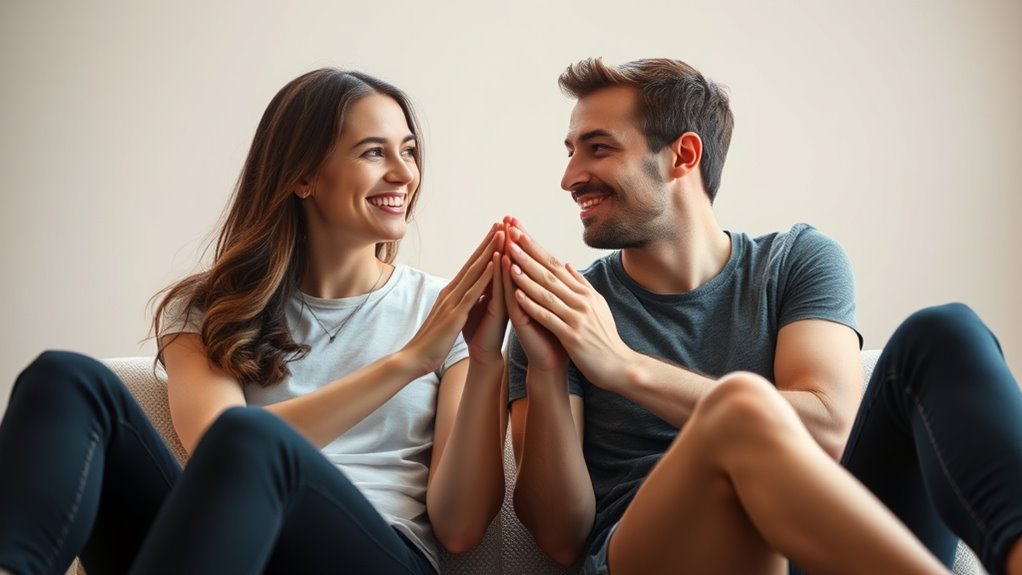Nonverbal synchrony involves subtly mirroring movements and body language during interactions, which can boost attraction and emotional connection. When you unconsciously match someone’s gestures or posture, it signals engagement, understanding, and openness. This mirroring creates a sense of harmony and can intensify feelings of mutual interest. Recognizing these cues helps you understand unspoken emotions. If you want to learn how this dance influences chemistry even more, keep exploring these fascinating dynamics.
Key Takeaways
- Nonverbal synchrony involves subconscious mirroring of body language that fosters emotional connection and trust.
- Mirroring movements signals interest and attraction, often occurring rapidly during engaging interactions.
- Increased nonverbal synchrony enhances feelings of ease, intimacy, and mutual understanding between individuals.
- Recognizing subtle cues of body language mirroring helps gauge unspoken attraction and emotional openness.
- Active awareness and matching of gestures can strengthen bonds and improve interpersonal rapport.

Nonverbal synchrony refers to the subtle mirroring and coordination of body language between individuals during interactions. When you engage with someone, your movements often align without conscious effort, creating a natural rhythm that enhances your connection. This synchronization isn’t just about copying gestures; it’s a fundamental way your body language communicates and builds an emotional connection. As you lean forward slightly or match their posture, you signal engagement and openness, making the other person feel understood and accepted. This unspoken dance helps establish trust and rapport, which are essential for forming a deeper bond.
Nonverbal synchrony creates emotional bonds through subconscious body language mirroring.
You might notice that when you’re attracted to someone or genuinely interested, your body naturally starts mirroring theirs. For instance, if they cross their legs, you might do the same moments later. If they lean in during a conversation, you tend to follow suit. This mirroring isn’t a coincidence; it’s a subconscious effort to create harmony and reinforce emotional connection. The more synchronized your body language, the more connected you feel, often leading to a sense of ease and intimacy. It’s as if your minds are aligning through physical cues, bypassing words and creating a shared experience.
This nonverbal mirroring also influences how others perceive your feelings. When your gestures and posture reflect theirs, it signals empathy and understanding, making interactions more comfortable. For example, if you’re speaking with someone and you notice they’re relaxed and open, mirroring their relaxed stance can encourage them to stay engaged. Conversely, if your body language is mismatched or stiff, it might create distance or miscommunication. By consciously or subconsciously adapting your body language to match theirs, you demonstrate attentiveness and foster emotional closeness.
Moreover, body language synchrony often intensifies during moments of mutual attraction. When two people are attracted, their movements tend to become more aligned, almost as if their bodies are communicating a shared desire or interest. This synchronization can happen quickly, sometimes within seconds of interaction, signaling genuine interest and emotional connection. It’s a powerful nonverbal cue that often predicts relationship development, because it reflects a mutual understanding that words might not fully express. Additionally, understanding the importance of high refresh rates and low input lag in interactive settings can help you recognize how seamless coordination enhances mutual engagement. When you pay attention to these subtle cues, you gain insight into the unspoken emotional currents flowing between you and others, deepening your understanding of how nonverbal synchrony influences attraction and connection.
Frequently Asked Questions
How Quickly Does Nonverbal Synchrony Develop During Interactions?
When it comes to initial response times, nonverbal synchrony can develop surprisingly quickly, often within minutes of interaction. Mirroring speed varies depending on comfort and familiarity, but it generally begins almost immediately as you subconsciously mirror gestures or posture. This rapid mirroring helps build rapport and attraction, making your nonverbal cues a powerful tool for connection from the very start of your interaction.
Can Nonverbal Synchrony Predict Long-Term Relationship Success?
Sure, because who wouldn’t want their emotional connection to hinge on subtle gestures? Nonverbal synchrony can indeed predict long-term relationship success, as it reflects mutual understanding and communication cues. When you mirror each other’s movements, you signal trust and harmony, laying the groundwork for deeper bonds. So next time you sync your movements, remember—you might just be building a future together, one gesture at a time.
Are There Cultural Differences in Nonverbal Mirroring Behaviors?
You might notice that cultural variations influence how people mirror each other’s movements. In some cultures, social norms encourage subtle or frequent mirroring, fostering connection, while others view it as intrusive. These differences shape nonverbal behaviors, making mirroring more or less common depending on cultural context. Understanding these social norms helps you interpret nonverbal cues accurately, recognizing that what’s natural in one culture might be different in another.
Does Nonverbal Synchrony Occur in Virtual or Digital Interactions?
You might wonder if nonverbal synchrony shows up in virtual or digital interactions. It does, through virtual cues like synchronized gestures, facial expressions, and tone of voice. When you and someone else engage in video chats or messaging, you can still build digital rapport by mirroring these cues. This subconscious mirroring helps deepen connection, even across screens, demonstrating that nonverbal synchrony extends beyond face-to-face encounters.
How Can Individuals Improve Their Nonverbal Synchrony Skills?
Think of nonverbal synchrony as a dance where you guide your partner’s rhythm. To improve your skills, boost your body language awareness by observing cues like posture and gestures. Practice active mirroring techniques—subtly mimicking movements and expressions—to build connection. Stay present and attentive during interactions, and you’ll naturally enhance your ability to synchronize nonverbally, creating rapport and trust that feels as seamless as a well-choreographed dance.
Conclusion
You can’t ignore the incredible power of nonverbal synchrony—it’s like a secret language that reveals genuine connection and attraction. When you mirror someone’s movements, you’re not just copying; you’re forging an almost magical bond that deepens trust and sparks attraction. This subtle dance influences how others perceive you more than words ever could. So, next time you want to build a real connection, remember: your body might be the most persuasive tool you have, invisible yet unstoppable.










